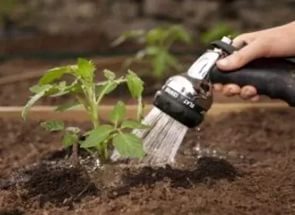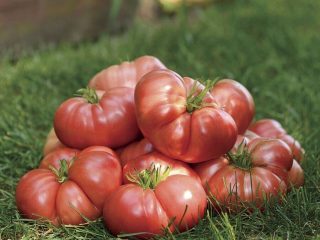Content
When growing tomatoes, we want to get a high yield, tasty fruits and spend a minimum of effort. Often we only take from the earth, without giving anything in return, and then we hope either for luck or for the eternal “maybe.” But tomatoes don't grow themselves without difficulty, knowledge of agricultural technology, fertilizing and treatments. You can’t bargain with nature; as soon as the earth gives up its accumulated supply of nutrients, yields fall and tomatoes become tasteless.
Tomato is a demanding crop. There should not be a lot of fertilizing, they need to be given wisely - if you thoughtlessly pour fertilizers under the roots, you may not get a good harvest or ruin it completely. At different stages of development, tomatoes need different nutrients. Today we will tell you what to feed tomatoes after planting into the ground.
Have vegetables grown without fertilizing before?
You can often hear that everything used to grow without fertilizing, of course. Our ancestors didn’t subscribe to newspapers, didn’t have the Internet, didn’t read smart books, but somehow managed to feed the whole of Europe.
But for some reason people forget that peasant families used to cultivate the land from generation to generation, traditions and competent work on it were instilled in them from childhood.The farming culture was high, no work was carried out at random. In addition, the land was cultivated without heavy equipment and was always fertilized with organic matter.
Yes, our ancestors did without chemical fertilizers, but in peasant farms there was always an abundance of manure; then they heated exclusively with wood, and food was not cooked on a gas stove. Everything went to the fields and gardens to fertilize the soil - manure, ash, fallen leaves. Clay, sand, bottom silt, peat, and chalk were brought from nearby forests, ravines, rivers or swamps. Our wise predecessors found application for everything.
Why do you need fertilizing?
All tomatoes grown in the gardens and fields of large farms are varieties and hybrids created by people specifically to obtain marketable products. They do not grow in the wild and simply cannot survive without human help. In one year, cultivated tomatoes must germinate from seed, grow, bloom, set and bear fruit.
In addition, we want to harvest not one or two tomatoes from a bush, but a full-fledged harvest, which in central Russia in open ground can reach 5-10 kg per bush. And this is on average, usually a little less fruit is obtained from low-growing tomatoes, and more from tall tomatoes grown on a trellis or in greenhouses.
For flowering and fruit ripening, tomatoes need nitrogen, phosphorus, potassium, trace elements. It is clear that a tomato will not be able to take as many nutrients from the soil. Timely, correct application of fertilizers improves soil fertility, increases the yield and quality of tomatoes.
- Nitrogen participates in the formation and development of tomatoes at all stages of life. It is needed for photosynthesis, but it plays the greatest role in increasing the green mass of tomatoes immediately after planting.A lack of nitrogen affects the tomato yield, and an excess leads to the accumulation of nitrates in the pulp.
- Phosphorus It is especially important for the flowering and fruiting of tomatoes; if it is deficient, the flowers and ovaries fall off. Thanks to this element, tomatoes ripen faster, the fruits grow large and have an intense color. Tomatoes that do not experience phosphorus deficiency are less likely to get sick.
- Potassium has the greatest influence on the development of the tomato root system. If it is weak, it simply will not be able to deliver moisture and nutrients to other parts of the tomatoes. A lack of potassium fertilizer makes tomatoes sickly and their fruits small.
- Microelements do not play a decisive role in the life of tomatoes, which are essentially perennial plants, but are grown as annuals. Their shortage will simply not become critical during the season. But microelements significantly affect the resistance of tomatoes to diseases and the quality of the fruit. If there is a shortage of them, the tomato gets sick, the fruits crack, and the taste and marketability decrease. Everyone's tired of ineradicable late blight is a lack of copper, and its treatment with copper-containing preparations largely eliminates the deficiency of this element.
How to fertilize tomatoes
Tomatoes are big fans of phosphorus. They are able to bear fruit for a long time. The first tomatoes in the southern regions appear in mid-June, and the latter, in the absence of late blight and good care, simply do not have time to ripen before frost.One tomato simultaneously contains flowers, ovaries and ripe fruits. It is not surprising that feeding tomatoes requires a lot of phosphorus.
Tomato seedlings are fed 2-3 times even before planting in the ground. First time, after about 10 days after the pick, fertilizers for seedlings in low concentration, the second - a week later with the same special fertilizers or a teaspoon solution azofoski in 10 liters of water. During this period, tomatoes need nitrogen. With normal development of tomato seedlings, no further fertilizing is carried out before transplanting.
Mineral supplements
When planting a tomato, pour a handful of ash into the hole and be sure to add a tablespoon of superphosphate. After about two weeks, when the seedlings take root and begin to grow, do the first fertilizing of the tomatoes in the ground. Dissolve in 10 liters of water:
- phosphorus – 10 g;
- nitrogen – 10 g;
- potassium – 20 g
and pour 0.5 liters under the tomato bush.
The next time you feed a tomato, which needs to be done after 2 weeks, take:
- nitrogen – 25 g;
- phosphorus – 40 g;
- potassium – 15 g;
- magnesium – 10 g,
- dissolve in 10 liters of water and water 0.5 liters per bush.
In the summer, when tomatoes begin to ripen, it is important to feed them every 2 weeks with nutrient solutions consisting of safe ingredients. The infusion of ash has proven itself very well; it is an invaluable source of potassium, phosphorus and calcium - precisely those elements that tomatoes need during their ripening period. There is little nitrogen there, but it is no longer needed in large quantities. Prepare the infusion as follows:
- Pour 1.5 liters of ash into 5 liters of boiling water.
- When the solution has cooled, add up to 10 liters.
- Add a bubble iodine, 10 g boric acid.
- Leave for a day.
- Dissolve 1 liter of infusion in a bucket of water and pour 1 liter under a tomato bush.
This cocktail will not only feed the tomatoes, but also, due to the presence of iodine in it, will serve as a preventive measure for late blight.
Foliar feeding
Often foliar feeding tomatoes They are called fast, they act directly on the leaf and the result is visible literally the next day. They can be carried out every 10-15 days and, if necessary, combined with tomato treatments for pests and diseases.
You can spray tomatoes leaf by leaf with the same fertilizers that you pour at the root. It is very good to add a tomato to a bottle with a working solution for foliar feeding:
- an ampoule of epin or zircon – these are biologically pure immunostimulants that are practically safe for humans and bees. Their effect on tomatoes can be compared to the effect of vitamins on people;
- humate, humisol or other humic preparation.
Environmentally friendly fertilizers
Nowadays, more and more gardeners are trying to use organic farming methods on their plots. Growing tomatoes allows you to get by with environmentally friendly, chemical-free fertilizers, especially in the fruiting phase. Tomatoes do not like fresh manure, but they treat its fermented infusion very favorably. It is prepared simply:
- Fill 1 bucket of manure with a bucket of water, leave for a week;
- Dilute 1 liter of infusion in a bucket of water;
- Pour 1 liter of diluted infusion under each tomato bush.
Not all summer residents have access to manure. It doesn’t matter, herbal infusion is an equally valuable fertilizer for tomatoes.Fill the largest container on the site to the top with weeds and plant debris, close, and leave for 8-10 days. Dilute 1:5 with water and use to feed tomatoes.
You can prepare a universal balm for tomatoes. It will require:
- 200 liter capacity;
- 2 liters of ash;
- 4-5 buckets of green nettles.
All this is filled with water and infused for 2 weeks. One liter of balm is used to feed a tomato bush. If you don't have such a large container, reduce the ingredients proportionally.
General rules for feeding tomatoes
The best results are obtained by comprehensive feeding of tomatoes. To achieve the best result and not harm the plant, you need to remember a few simple rules:
- It is better to underfeed tomatoes than to overfeed them.
- Planted in the ground tomato seedlings you need to feed when the temperature exceeds 15 degrees; at lower temperatures, the nutrients are simply not absorbed.
- Fertilize tomatoes at the root in the late afternoon.
- foliar feeding of tomatoes carried out early in the morning in calm, dry weather. It is advisable to finish them before 10 am.
- Do not use pesticides during the flowering or fruiting period of tomatoes unless absolutely necessary. Try to treat tomatoes with folk remedies.
- It is best to combine root feeding of tomatoes with watering, and foliar feeding with treatments against pests and diseases.
We offer you to watch a video that tells you how to feed tomatoes after planting:
Signs of battery shortage
Sometimes we do everything right, but the tomatoes grow and bear fruit poorly. There seem to be no pests, the disease cannot be determined, but the tomato bush is clearly suffering. This may be caused by a lack of some kind of battery. We will teach you how to determine which one based on external signs.
| Battery | External signs | Necessary measures |
|---|---|---|
| Nitrogen | Tomato leaves are matte, with a gray tint, or light and small | Feed the tomatoes with infusion weed or any nitrogen-containing fertilizer |
| Phosphorus | The lower part of the tomato leaf plate has acquired a purple hue, the leaves themselves are raised up | Feeding tomatoes will give the fastest effect superphosphate extract: Pour a glass of fertilizer with a liter of boiling water, let it brew for 12 hours. Add up to 10 liters, water 0.5 liters per tomato bush |
| Potassium | The edges of tomato leaves dry out, and they themselves curl up | Feed the tomatoes with potassium nitrate or another non-chlorine potassium fertilizer |
| Magnesium | Marbled dark or light green color of tomato leaves | Sprinkle half a glass of dolomite over the damp soil under each tomato bush. |
| Copper | Late blight | Treatment of late blight of tomatoes |
| Other trace elements | Yellow-green mosaic coloring of tomato leaves | Treat tomato bushes with a chelate complex. If after 5-7 days there is no effect, remove and burn the plant, this is not a lack of microelements, but the tobacco mosaic virus. |
Conclusion
We told you how to feed tomatoes after planting in the ground, and gave advice on the use of mineral and organic fertilizers. We hope you found the article useful. Good luck to you and have a good harvest!






















